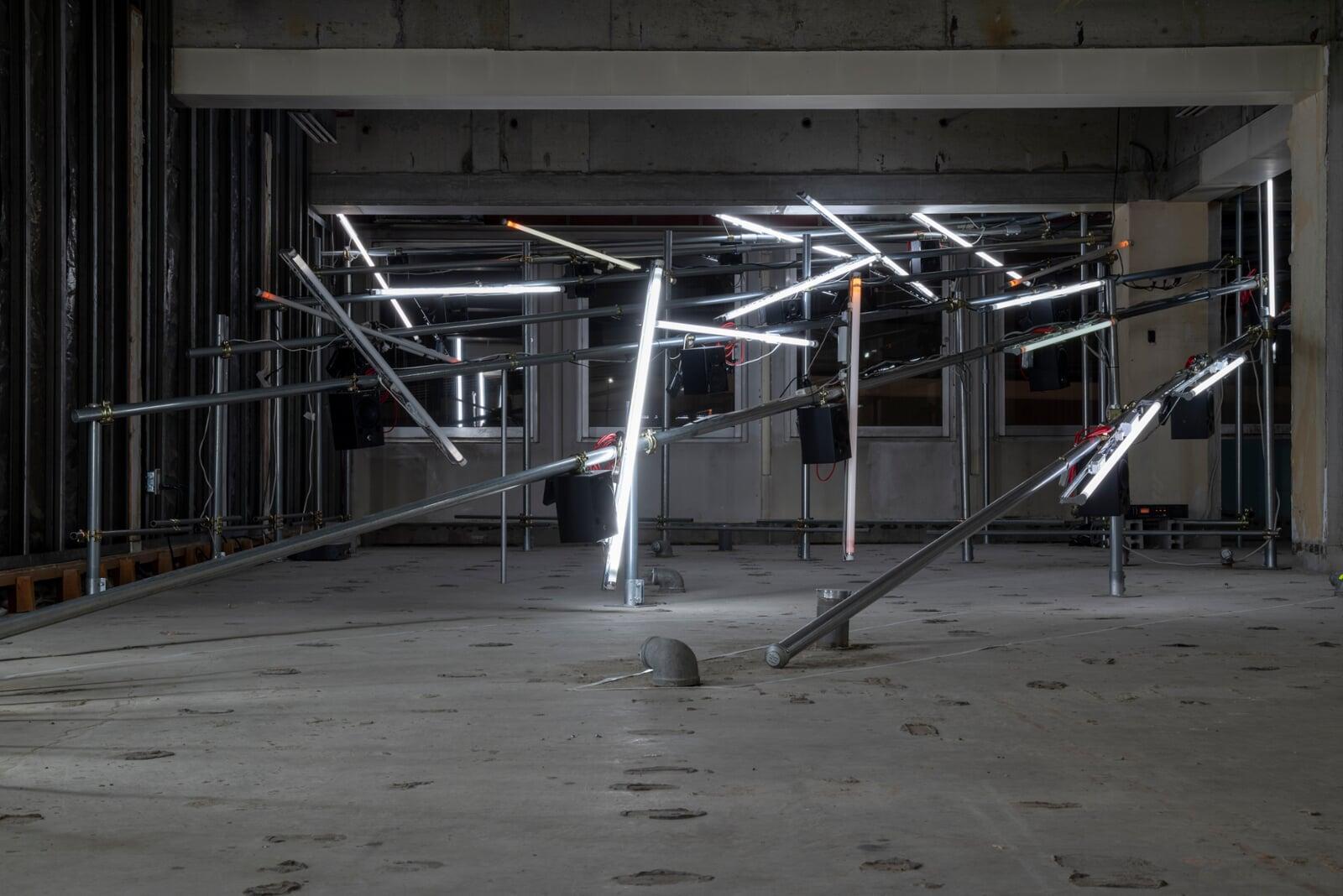テレ・インターフェアレンス・カウンターポインツ(千葉にて)
テレ・インターフェアレンス・カウンターポインツ(千葉にて)
千葉国際芸術祭2025 展示本会期が開幕しました。
千葉市内外で古い蛍光灯・使わない蛍光灯の回収とリサーチ、コミュニケーションを経て構築した、「Tele-Interference Counterpoints (in Chiba)」を、千葉駅からほど近い第一山崎ビル9階で発表・展示しております。
千葉国際芸術祭2025の公募プログラム「ソーシャルダイブ」に選出されたのち、2025年4月からの芸術祭プレ期間中に回収した蛍光灯を中心に構成された、全20チャンネルのライト/サウンドインスタレーションです。蛍光灯にかんする対話と、講義とワークショップと体験の資料や記録も展示会場内にあります。
ぜひともご高覧ください。
千葉国際芸術祭2025
Chiba City Arts Triennale 2025
上野悠河 Tele-Interference Counterpoints (in Chiba)
会期:2025年9月19日㈮〜11月24日㈪㈷
※毎週水曜定休
時間:10:00〜18:00
会場:第一山崎ビル 9階
〒260-0015 千葉県千葉市中央区富士見2丁目9−28 第一山崎ビル
アクセス:JR千葉駅から徒歩約7分、京成千葉駅から徒歩約6分
※千葉国際芸術祭2025についてのお問い合わせは芸術祭専用お問い合わせ窓口からお願いします。各施設・拠点へのお問い合わせはお控えください。
入場無料

上野悠河 Tele-Interference Counterpoints (in Chiba)
明滅する蛍光灯(グロー・スターター)、ラジオ、スピーカー、パイプほか 全20ch. 2025
本作は、千葉市内を中心とした各所で廃棄予定の蛍光灯を回収・整備し、複数台のラジオやスピーカー等を組み合わせて、光と音によるインスタレーション・アートとして「再生」する/させる一連のプロジェクトである。たんに完成作品として展示するのみならず、各所から蛍光灯を集める「回収フェーズ」を経て、集めた蛍光灯による明滅する光の現象を展開させる「展示フェーズ」へ至る構成とした。
本プロジェクトは、従来の蛍光灯が2027年に製造・輸出入禁止となる、いわゆる「蛍光灯2027年問題」を背景に遂行された。実際、転換期にあたる現在は各所で蛍光灯の置き換えと同時に廃棄を伴う流れが加速している。
これまで作者は捨てられかけた蛍光灯を各所から集め作品に用いてきたが、本プロジェクトの「回収フェーズ」では交換→廃棄のプロセスの間に、回収に加えて地域を巻き込んだ蛍光灯に関するレクチャーや対話のコミュニケーションを組み入れている。講演やワークショップを通して、蛍光灯の仕組みから実態を相互に再認識しつつ、消えゆく蛍光灯の印象や経験を共有し記録/記憶することを本フェーズの目標と定めた。
つぎの「展示フェーズ」では、集めた蛍光灯を明滅させ、複数台のラジオ、スピーカー等を組み合わせて、展示作品として本作「Tele-Interference Countepoints (in Chiba)」を構築した。マルチチャンネルの蛍光灯とAMラジオ、スピーカーを組み合わた本作は、蛍光灯から発せられる電磁波がラジオの電波(中波帯)に干渉しやすい現象を利用し、チカチカと自ら明滅する古い蛍光灯のリアルタイムに生成されるさまざまなノイズを、ラジオが継続的に聴取し発音する仕組みのインスタレーションである。その光と音が集積・氾濫することで空間内に新たな表情が生まれ続けるとともに、電磁波と道具の機能、ラジオの音声とノイズを対立・衝突させることで、異なった側面から“もの”本来の性質: “もの性”があらわれる現象を「カウンターポイント」(対位法)と示した作品である。
また展示と並行して、従来の蛍光灯の仕組みや種類、回収フェーズやイベント・ワークショップにおいて記録した素材にまつわる記憶、経験の共有といったコンテクストやプロセスをオープンにし、発表している。
光と音のゆらぎは懐かしさやペーソスを想起させる一方、世代によっては新鮮なメディアとしても映る。さまざまな人の印象や想い、そして組み合わさることで変化し続ける時空間を、ふたつのフェーズで多層的に提示し、それまで身近にあった/無くなりつつある蛍光灯を通じて、“もの”と“もの”、“もの”と人、人と地域、消費と循環、記憶と未来をつなぐ美術の役割を、本プロジェクトを通して追究する。
Yuga Soma-Uéno Tele-Interference Counterpoints (in Chiba)
Fluorescent lamps (with glow starters), radios, speakers, pipes, and other materials, 20 channels, 2025
This project collects and refurbishes fluorescent lamps scheduled for disposal—primarily from sites in Chiba City—and combines them with multiple radios, speakers, and other devices in order to both revive these aging lamps and play them as media of light and sound within an installation artwork. The work is structured not only as a finished artwork but also as a process: beginning with a collection phase, in which lamps are gathered from various locations, and culminating in an exhibition phase, in which their flickering light phenomena are presented.
The project is grounded in the so-called “Fluorescent Lamp 2027 Problem,” arising from the forthcoming ban on the manufacture and trade of conventional mercury-based fluorescent lamps under the Minamata Convention. In this transitional period, the replacement and disposal of such lamps has accelerated dramatically. Since around 2017, the artist has been incorporating discarded lamps into his works; in this project’s collection phase, he also integrated lectures and dialogues with local communities. Through talks and workshops, participants revisited the mechanisms and histories of fluorescent lighting, while sharing and recording memories of its fading presence.
In the subsequent exhibition phase, the gathered lamps were configured to flicker in combination with multiple radios and speakers, resulting in the work Tele-Interference Counterpoints (in Chiba). This multi-channel installation exploits the tendency of electromagnetic waves emitted by fluorescent lamps to interfere with AM radio signals. Old, self-flickering lamps generate noise in real time, which the radios continuously capture and amplify. As the interplay of light and sound accumulates and overflows, the installation produces ever-changing spatial atmospheres. By colliding electromagnetic radiation with functional devices, and radio voices with noise, the work stages a counterpoint that reveals different dimensions of the intrinsic nature of objects.
In parallel with the exhibition, the project also makes public its contextual layers: explanations of fluorescent lamp mechanisms and types, documentation from the collection phase, and shared recollections of experiences and memories tied to these materials.
The flickering of light and sound evokes nostalgia and pathos for some, while appearing as a novel medium to others. Across its two phases, the project offers a multilayered presentation of impressions, emotions, and shifting spatiotemporal experiences. Through the presence—and disappearance—of the once-familiar fluorescent lamp, it explores the role of art in connecting objects with objects, objects with people, people with communities, consumption with circulation, and memory with the future.
上野悠河 Yuga Soma-Uéno
1997年千葉県生まれ、千葉県在住。
現代音楽への関心やオーケストラの打楽器に所属していた経験から、1960〜70年代の美術史研究を経て、現代における人間や「もの」の複雑な振る舞い、関係性、有限性に焦点を当てた作品を発表している。美術や音楽に関するほとんどすべての技術を独学で習得した上で、レディ・メイドの道具や機材、その機能を実際に利用し組み合わせたサウンド・アート、インスタレーション・アートを主軸に表現しているほか、ミュージシャン「Mus’c」(ムスク)としても活動。
近年の展示に、個展「独奏・曲・のための・奏者」(あをば荘/東京)、個展「ものたちは、歌い、蔑み、愛し合った」(千葉市民ギャラリー・いなげ/旧神谷傳兵衛稲毛別荘/千葉)、「SICF23 EXHIBITION部門 受賞者展」 (スパイラル/東京)、「ZOU-NO-HANA FUTURE SCAPE PROJECT 2022」(象の鼻テラス/横浜)など。
「ClafT(中央線芸術祭)」に2021年から参加・出展。また「SICF23」大巻伸嗣賞、「第二回ISAC国際作曲コンテスト」Special Prize (Special Mentioned)、「島村楽器 録れコン2022」グランプリなど、展示/受賞多数。